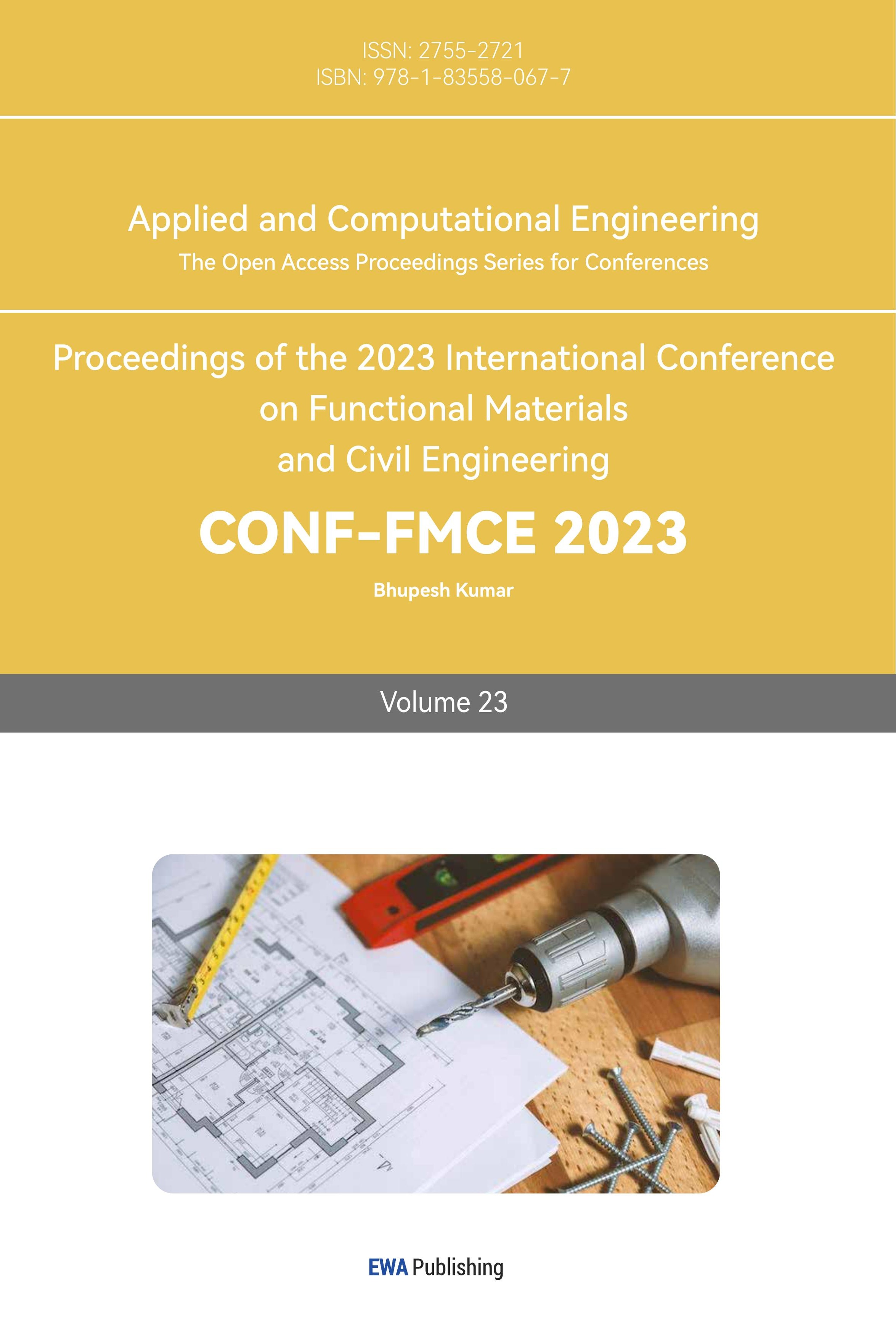References
[1]. Zhang W S, et al. 2022. Hydraulics and Pneumatics 46.05: 215-220.
[2]. Zhang K, et al. 2019. Journal of Tianjin University of Technology 35.03: 43-47.
[3]. Wang Y. 2022. Fiber Composites 39.01: 77-81.
[4]. Shen S Y, et al. 2022 Plastic Industry 50.10: 141-148.
[5]. Liang Y J, et al. 2022 Henan Chemical Industry 39.08: 17-20. doi:10.14173/j.cnki.hnhg.2022.08. 002.
[6]. Xiong Y L, et al. 2022 Silicate Bulletin 41.08: 2896-2903+2962. doi:10.16552/j.cnki.issn1001- 1625.2022.08.019.
[7]. Qiu J, et al. 2020 Applied Chemistry 37.08: 904-911.
[8]. Ju Y C, et al. 2022 Journal of Inorganic Materials 37.01: 86-92.
[9]. Fang J M, et al. 2022 Missile and Space Vehicle Technology .04: 77-79.
[10]. Tang L M, et al. 2022 Natural Science Edition 46.05: 83-88.
[11]. Fang G W, et al. 2022. Computer Aided Engineering 31.01: 39-44.
[12]. Cao L, et al. 2021. Precision Forming Engineering 13.03: 9-24.
[13]. Fang X X, et al. 2022. High-tech Fiber and Application 47.02: 70-73.
[14]. Wang H F, et al. 2019. Materials Herald 33.S1: 78-83.
[15]. Fei G X, Gong Q C, and Xia H S. 2021. Polymer Materials Science and Engineering 37.01: 128-133.
[16]. Zhang G X, et al. 2013. Natural Science Edition 39.01:8-17. doi:10.14135/j.cnki .1006-3080.2013.01.020.
[17]. Yan Y F, Wang R, and Xu F. 2021. Science Technology and Engineering 21.14:6057-6062.
[18]. Du K, et al. 2022. Propulsion Technology 43.02:113-131. doi:10.13675/j.cnki.tjjs.210380.
[19]. Ding M, et al. 2021. Journal of Electrotechnical Society 36.23: 5046-5057. doi:10.19595/j .cnki.1000-6753.tces.l90374.
[20]. Chen Z, and Li C Q. 2019. Rubber and Plastic Technology and Equipment 45.21: 1-8
Cite this article
Ran,Z. (2023). Application of carbon nanotube composite materials in aviation. Applied and Computational Engineering,23,177-182.
Data availability
The datasets used and/or analyzed during the current study will be available from the authors upon reasonable request.
Disclaimer/Publisher's Note
The statements, opinions and data contained in all publications are solely those of the individual author(s) and contributor(s) and not of EWA Publishing and/or the editor(s). EWA Publishing and/or the editor(s) disclaim responsibility for any injury to people or property resulting from any ideas, methods, instructions or products referred to in the content.
About volume
Volume title: Proceedings of the 2023 International Conference on Functional Materials and Civil Engineering
© 2024 by the author(s). Licensee EWA Publishing, Oxford, UK. This article is an open access article distributed under the terms and
conditions of the Creative Commons Attribution (CC BY) license. Authors who
publish this series agree to the following terms:
1. Authors retain copyright and grant the series right of first publication with the work simultaneously licensed under a Creative Commons
Attribution License that allows others to share the work with an acknowledgment of the work's authorship and initial publication in this
series.
2. Authors are able to enter into separate, additional contractual arrangements for the non-exclusive distribution of the series's published
version of the work (e.g., post it to an institutional repository or publish it in a book), with an acknowledgment of its initial
publication in this series.
3. Authors are permitted and encouraged to post their work online (e.g., in institutional repositories or on their website) prior to and
during the submission process, as it can lead to productive exchanges, as well as earlier and greater citation of published work (See
Open access policy for details).
References
[1]. Zhang W S, et al. 2022. Hydraulics and Pneumatics 46.05: 215-220.
[2]. Zhang K, et al. 2019. Journal of Tianjin University of Technology 35.03: 43-47.
[3]. Wang Y. 2022. Fiber Composites 39.01: 77-81.
[4]. Shen S Y, et al. 2022 Plastic Industry 50.10: 141-148.
[5]. Liang Y J, et al. 2022 Henan Chemical Industry 39.08: 17-20. doi:10.14173/j.cnki.hnhg.2022.08. 002.
[6]. Xiong Y L, et al. 2022 Silicate Bulletin 41.08: 2896-2903+2962. doi:10.16552/j.cnki.issn1001- 1625.2022.08.019.
[7]. Qiu J, et al. 2020 Applied Chemistry 37.08: 904-911.
[8]. Ju Y C, et al. 2022 Journal of Inorganic Materials 37.01: 86-92.
[9]. Fang J M, et al. 2022 Missile and Space Vehicle Technology .04: 77-79.
[10]. Tang L M, et al. 2022 Natural Science Edition 46.05: 83-88.
[11]. Fang G W, et al. 2022. Computer Aided Engineering 31.01: 39-44.
[12]. Cao L, et al. 2021. Precision Forming Engineering 13.03: 9-24.
[13]. Fang X X, et al. 2022. High-tech Fiber and Application 47.02: 70-73.
[14]. Wang H F, et al. 2019. Materials Herald 33.S1: 78-83.
[15]. Fei G X, Gong Q C, and Xia H S. 2021. Polymer Materials Science and Engineering 37.01: 128-133.
[16]. Zhang G X, et al. 2013. Natural Science Edition 39.01:8-17. doi:10.14135/j.cnki .1006-3080.2013.01.020.
[17]. Yan Y F, Wang R, and Xu F. 2021. Science Technology and Engineering 21.14:6057-6062.
[18]. Du K, et al. 2022. Propulsion Technology 43.02:113-131. doi:10.13675/j.cnki.tjjs.210380.
[19]. Ding M, et al. 2021. Journal of Electrotechnical Society 36.23: 5046-5057. doi:10.19595/j .cnki.1000-6753.tces.l90374.
[20]. Chen Z, and Li C Q. 2019. Rubber and Plastic Technology and Equipment 45.21: 1-8









